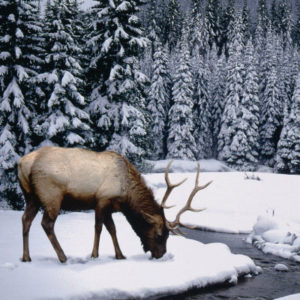 With snow, ski season, and the holidays upon us, it is easy to tell that we’ve made it into the winter season. Luckily, winter doesn’t mean we have to stay indoors! The Eagle Valley offers the opportunity to ski, snowboard, snowshoe, sled and a wide variety of other activities that allow us to stay active and outdoors in the winter. However, unlike us, many animals are not able to remain active and outdoors for the winter due to the bitter cold. Animals have a variety of mechanisms they use to survive the cold winters, three of the strategies animals use to survive the winter are: adapting, hibernating, or migrating.
With snow, ski season, and the holidays upon us, it is easy to tell that we’ve made it into the winter season. Luckily, winter doesn’t mean we have to stay indoors! The Eagle Valley offers the opportunity to ski, snowboard, snowshoe, sled and a wide variety of other activities that allow us to stay active and outdoors in the winter. However, unlike us, many animals are not able to remain active and outdoors for the winter due to the bitter cold. Animals have a variety of mechanisms they use to survive the cold winters, three of the strategies animals use to survive the winter are: adapting, hibernating, or migrating.
For us humans, adapting to the winter means turning up the heat in our houses, wearing winter coats, and finding activities to replace the things we can no longer do outside. For animals, adapting is a bit more difficult. Animals like elk and moose adapt to the frigid temperatures by growing thicker coats to keep them warm, these coats will then be shed in the spring. Similarly, some animals change the color of their coats. Snowshoe hare’s coats change to white—which is warmer and better at camouflaging with the snow. White fur is warmer because the lack of pigment leaves more room for air to be trapped in the fur. Once this air is warmed by the body, it acts as an extra layer of insulation to keep the animal warm.
Another way animals can adapt to cold weather is by using snow as an insulator, similar to humans who build igloos. Whole ecosystems live between the ground and the snow, this ecosystem was is known as the subnivian zone. Invertebrates, small mammals, reptiles, amphibians, and even birds hide out in this region—protected from the harsh winter weather above the surface. These animals live off the vegetation found underneath the snow.
While many of us will spend more time sleeping this holiday season, some Rocky Mountain animals turn to hibernating to make it through the cold Colorado winters. Bears are some of the best known hibernators. While in hibernation, bears still burn 4,000 calories a day, meaning they need to store up many thousands of calories in their fat rolls in order to survive the long winters. Another well-known hibernator is the marmot, which will sleep in their burrows below the snow for even longer than bears. Marmots can hibernate for up to eight months! They’ve been hibernating since about September and will wake up sometime in May. In their state of hibernation, marmots’ heart rate will drop to less than ten beats per minute and they will take less than five breaths per minute.
Finally, some animals move south for the winter to escape the cold winters here. Birds, bats, butterflies and other insects fly south to Mexico to pass the winter in a much warmer climate. The monarch butterflies are one of the most famous migrators—the population east of the Rocky Mountains migrates to the Mariposa Monarca Biosphere Reserve in Mexico and parts of Florida. The western population spends winter in various coastal sites in central and southern California.
These amazing animals will all be back in the Spring as temperature warms back up and the beautiful summer landscapes of Colorado begin to come alive again. And for those animals that adapt or hibernate, they will have to hope that they have saved up enough energy to last.
Aaron Matheson is a Naturalist at Walking Mountains Science Center and a lover of Colorado winters.









